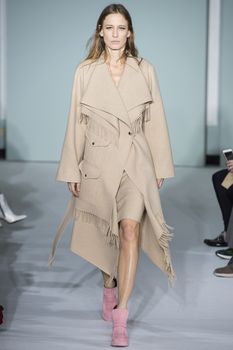Natasa Vojnovic Hates Instagram, Loves Posing, and Is Here to Stay
Some models are notable for what they do when they’re off duty—for what they wear, who they’re dating, or what they’re tweeting. Others rise to the top based solely on their work, their performance on the catwalk or in photo shoots elevating them to a favored position among photographers, designers, and casting directors. Natasa Vojnovic falls into the latter category. Starring in campaigns for Calvin Klein and Chanel, looming over the Paris Fashion Week audience in Ruth Hogben’s videos for Gareth Pugh, and strutting in Nicolas Ghesquière’s seminal collections, Vojnovic has earned a reputation as a model’s model. “You have two different kinds of models: the models who work it out in the outside world, and the models who work it out in the studio,” Vojnovic says. “I work it out in the studio. Going out there, hanging out with people at parties, that’s not my kind of deal.”
Vojnovic and her family fled from the conflict in former-Yugoslavia when she was 12 and resettled in Belgrade. The experience of being a refugee left a lasting impact on her life and work ethic. “The first time I came from Bosnia to Paris, a part of me was like, ‘I’m going to commit and I’m going to give my everything, and we’ll see where it’s going to go,’” says Vojnovic, who was a finalist in the Elite Model Look contest in 1997. She hoped to start a new life in Paris as a model, but not everyone was convinced. “I arrived at my [first] agency very tired, because I had taken a train and it took a very long time; I think it was 48 hours. And they were like, “I think she needs to go back home,” says Vojnovic. “I had to convince them to give me a chance.” She changed her management and paid her dues by working with some of the era’s most important designers. “When I came in from Bosnia, I was a wild child. It took some time—almost three years—for people like Karl Lagerfeld and Nicolas Ghesquière to look at that little child and say, ‘She’s amazing.’”
Working with Ghesquière and Lagerfeld helped. “Karl is so knowledgeable, Nicolas also. You see them and talk to them, you learn so much,” says Vojnovic. “I think it’s important that you appreciate getting there. Be patient getting to the top—you’re on top, so where do you go from there? Nowhere. Or you go down.” She soon caught on with stylists and photographers, and become renowned for being game for any transformation or concept. She has changed her hair color, been doused in body paint, and shaved off her eyebrows, all for the sake of bringing a great visual to life. “I’m just a canvas, and people make me into [something]. That’s what being a model is for me,” says Vojnovic. “You have to believe in the process. You can’t say, ‘Oh, they don’t like me anymore!’ It’s not about me; it’s about image. That’s what my job is, to bring the image [about] in the best way with everyone involved.”
For Vojnovic, modeling is not a job for the faint of heart. “You really have to have passion to do this. If you don’t have passion, go home and sleep, go do something else,” says Vojnovic. “When I go back home, my aunt is like, ‘Natasa, you’ve just got to relax.’ And I’m like, ‘What do you mean I’ve got to relax? I’m just starting to live!’” Now 37, watching herself evolve over time has provided its own joys. “I feel like my pictures also grow and change, and there is another woman in them. And that is what’s good—I don’t mind my lines or getting older. I feel even better, and I don’t want to cover it up.”
http://www.vogue.com/13471237/natasa-vojnovic-20-years-interview/









































































































